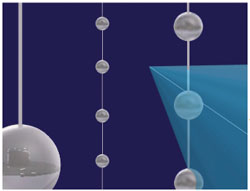|
|
|
|
 AMANDA Collaboration
AMANDA Collaboration |
| What's the matter?
If hidden dimensions exist, they could be the source of dark matter.
Experiments such as AMANDA, which consists of strings of detectors
buried vertically in the Antarctic ice, could detect the particles.
(Above, a neutrino triggers a cone of blue light.) |
|
|
|
|
Dark matter arising from extra spatial dimensions could be detected with existing or future experiments, according to the 18 November print issue of PRL.
If an additional dimension were hidden in the right way, heavier
replicas of the known particles might traverse space and account for
the mysterious "dark" component of the Universe's mass. Detecting the
unique particles would potentially confirm the existence of extra
dimensions and solve at least part of the dark matter riddle.
Researchers think that 30% of the Universe's mass is made up of
unknown particles that are invisible to telescopes but have
gravitational effects on galaxies. Potential culprits called
weakly-interacting massive particles (WIMPs) come from proposed
extensions to the standard model of particle physics, such as
supersymmetry and extra-dimensional theories. To verify the theories,
searches for some of these particles look to space, because particle
accelerators are too weak to produce them. But the big bang should have
produced every particle. "Maybe the Universe made them for us and
they're floating around out there and are dark matter," says Jonathan
Feng of the University of California at Irvine. "Now the [difficulty]
is you have to find them."
Kaluza-Klein particles are named for the two theorists who first
proposed that extra dimensions could be "curled up" to a size too small
for us to notice them. In the simplest case, these particles would be
much like those of the standard model, but would move through four
spatial dimensions instead of three. Their momentum along the fourth
dimension would appear as additional mass in three dimensions, so we
would observe heavy photons or heavy electrons, for example. The
smaller the extra dimension, the greater the mass.
Now Feng and his colleagues have found that Kaluza-Klein particles
would heat up or ionize a block of material such as germanium at rates
comparable to other dark matter candidate particles. They could also
annihilate each other in space, creating showers of ordinary particles.
The researchers calculated that Kaluza-Klein dark matter would generate
a unique, sharp positron signal, distinguishing it from the neutralinos
of supersymmetry. Because dark matter feels the gravitational force, it
would be drawn toward the sun's large mass and lead to an excess of
neutrino and muon showers from the sun's direction. The AMANDA neutrino
detector, buried within the Antarctic ice, or the Alpha-Magnetic
Spectrometer (AMS), an antimatter detector scheduled to fly on the
International Space Station in late 2005, could hunt out these signals.
"Kaluza-Klein dark matter is definitely worth looking for with
AMS," says Kate Scholberg of the Massachusetts Institute of Technology
in Cambridge, who works on the detector project. "The indirect
signature would be quite dramatic for some of the possible parameters
they discuss." She adds that detecting and distinguishing Kaluza-Klein
and supersymmetric dark matter would depend strongly on how nature
actually behaves, but coming up empty wouldn't rule them out, just
constrain their possible characteristics.
--JR Minkel
Kaluza-Klein Dark Matter
Hsin-Chia Cheng, Jonathan L. Feng, and Konstantin T. Matchev
Phys. Rev. Lett. 89, 211301
(issue of 18 November 2002)
|
|
|